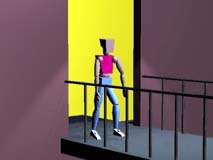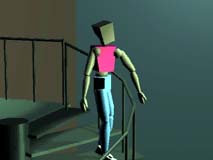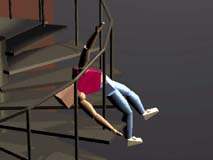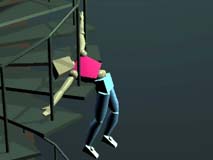

SOFTIMAGE®|3D version 3.7 or later on NT/Intel is required for this tutorial.




![]() Download
free demo version of Falling Bodies
plug-in with tutorial scene (1.0 MB)
Download
free demo version of Falling Bodies
plug-in with tutorial scene (1.0 MB)
![]() View completed movie (tutorial.avi) (1.5MB)
View completed movie (tutorial.avi) (1.5MB)
The fall stunt is a cliche of action movies and video games, and a tough bit of character animation. Fall stunts are hard to animate with keyframes, because the collisions with obstacles are hard to get right. Motion capture is hard on the actors. With Falling Bodies, fall stunts can be animated quickly and accurately. This effect is achieved in four steps.
For this tutorial, a pre-built scene, "Tutorial runfall-start" is provided. This scene is included in the download of the demo version.A character is provided; it's basically the standard Softimage|3D motion capture model.
You can change anything in the background, but when using this demo version of Falling Bodies, you can't change the character, other than moving him and bending him at his IK joints. For details on character-building, see the Falling Bodies manual.
Joint limits keep body parts connected to the same joint, like an upper arm and forearm, from going through each other. Everything else is handled by collision detection, which is complete and fully automatic.
Joint limits are set by selecting an IK joint and then using Motion->Constraint->Rotation Limits. The damping width should always be zero, and the damping strength should usually be 1.0. The joint limits should be set according to what real bodies can do.
Falling Bodies needs the last 2 degrees of rotation in each joint to slow down swinging limbs.So allow at least 4 degrees between MIN and MAX, and when animating, the last frame before Falling Bodies starts animating a fall can't have any joint within 2 degrees of its limits.
This character already has joint limits set.
The character is running along a railed catwalk, away from something behind him. He doesn't see the spiral staircase ahead. He runs off the end of the catwalk onto the spiral staircase and falls down the stairs, gets caught in the railing.
Once you've tried the basics above, you can try some other things. A few suggestions:
There's a Falling Bodies manual if you need it.
The message "You can't do that with the demo version" usually means you changed the character's geometry.
Messages like "axis Z of joint clavicle-D within 2 degrees of joint limit" mean that the indicated joint is too close to the joint limit. Falling Bodies needs the last 2 degrees of joint travel to slow down moving limbs. It's easy to get this if you use IK to position joints and IK was up against a joint limit. You may have to back off a joint angle a bit for the frame at which Falling Bodies gets control.
Sometimes Falling Bodies has to slow down for a difficult collision, but it usually speeds up again within a minute or two. These are the situations where most other dynamics systems break or give up.
Contact support@animats.com if you get stuck.
Animating Fall Stunts with Falling Bodies and Softimage|3D was created by John Nagle of Animats.
This tutorial is an example of the material that will be available to Softimage® Full Support customers as of January 1998 in the new Technique section of softimage.com. Technique will feature Tutorials, Demo Scenes, Plug-Ins, Shaders, and Standalones from animators, programmers, educators, and technical support engineers at Softimage.
If you are currently a SOFTIMAGE|3D user, you can find out about the status
of your Softimage Full Support contract from your Softimage Reseller. If
you are unable to contact your reseller, Anick @ i-anickg@microsoft.com
will be glad to help you with any questions.
To receive further information about Softimage products, please use
the Softimage Info
Request Form.
To receive further information about Animats products, visit www.animats.com, or mail to info@animats.com
Questions or comments about the Softimage tutorial series can be sent to Robert
McFadden, SupportContent Webmaster @ robmcf@microsoft.com.
©Copyright 1997 Animats. All rights reserved.
Microsoft®, MS®, Windows®, and Windows NT® are registered
trademarks of Microsoft Corporation in the United States, and/or other
countries.
SOFTIMAGE® is a registered trademark of Softimage Inc., in the United
States, Canada, and/or other countries.
This page is historical. Softimage|3D is no longer a product of Microsoft.